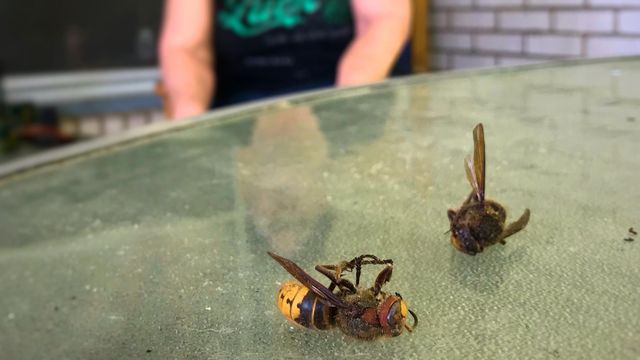'Murder Hornets,' with sting that can kill, land in US
The world's largest hornet, a 2-inch killer dubbed the "Murder Hornet" with an appetite for honey bees, has been found in Washington state, where entomologists were making plans to wipe it out.
Posted — UpdatedThe giant Asian insect, with a sting that could be fatal to some humans, is just now starting to emerge from winter hibernation.
“They’re like something out of a monster cartoon with this huge yellow-orange face,” said Susan Cobey, a bee breeder at Washington State University.
“It’s a shockingly large hornet,” said Todd Murray, a WSU Extension entomologist and invasive species specialist. “It’s a health hazard, and more importantly, a significant predator of honeybees.”
The hornet was sighted for the first time in the U.S. last December, when the state Department of Agriculture verified two reports near Blaine, Wash., close to the Canadian border. It also received two probable, but unconfirmed, reports from sites in Custer, Wash., south of Blaine.
The hornet can sting through most beekeeper suits, deliver nearly seven times the amount of venom as a honeybee, and sting multiple times, the department said, adding that it ordered special reinforced suits from China.
The university said it isn't known how or where the hornets arrived in North America. It normally lives in the forests and low mountains of eastern and southeast Asia and feeds on large insects, including wasps and bees. It was dubbed the “Murder Hornet” in Japan, where it is known to kill people.
"Likely, one of them found a hiding place on a container at the port and took a cruise over to the United States," said Michael Waldvogle, a North Carolina State University entomologist.
The hornet’s life cycle begins in April, when queens emerge from hibernation, feed on plant sap and fruit, and look for underground dens to build their nests. Hornets are most destructive in the late summer and early fall. Like a marauding army, they attack honeybee hives, killing adult bees and devouring larvae and pupae, WSU said.
Their stings are big and painful, with a potent neurotoxin. Multiple stings can kill humans, even if they are not allergic, the university said.
"They're murdering honeybees," Waldvogle said, adding that the sudden national interest in the insect is a combination of branding and timing.
"I think it's one of those things where 'murder hornet' kind of feeds the frenzy, and it's a distraction from coronavirus," he said.
Farmers depend on honeybees to pollinate many important Northwest crops such as apples, blueberries and cherries. With the threat from giant hornets, “beekeepers may be reluctant to bring their hives here,” said Island County Extension scientist Tim Lawrence.
An invasive species can dramatically change growing conditions, Murray said, adding that now is the time to deal with the predators.
“We need to teach people how to recognize and identify this hornet while populations are small, so that we can eradicate it while we still have a chance,'' Murray said.
The state Department of Agriculture will begin trapping queens this spring, with a focus on Whatcom, Skagit, San Juan and Island counties.
North Carolinians don't need to worry about the hornet yet, Waldvogle said, although some residents believe they have nests in their yards.
"They're large, whatever they are," Randolph County resident Valery Furlong said. "They're nasty. I mean I can't imagine getting stung by this."
"We try to belay their fears and say it's a European hornet," Waldvogle said. "That's the good news. The bad thing is that it still stings."
The North Carolina Department of Agriculture & Consumer Services is on the lookout for the new hornets, although they agree that none have been found in the state to date.
"There are many wasp and hornet lookalikes that are beneficial insects, so residents are asked to exercise caution before deciding to kill any large hornets," Agriculture Commissioner Steve Troxler said in a statement.
Hunting murder hornets is no job for ordinary people.
“Don’t try to take them out yourself if you see them,” Looney said. “If you get into them, run away, then call us.''
• Credits
Copyright 2024 by WRAL.com and the Associated Press. All rights reserved. This material may not be published, broadcast, rewritten or redistributed.





